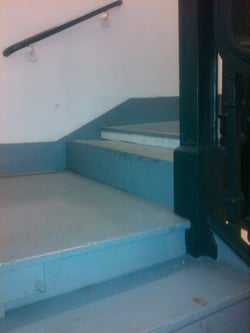 The International Building Code (IBC) Section 1009.4.4 requires stair risers and tread widths to be uniform height and width within a tolerance of 3/8 inch throughout the entire flight of stairs. Why is this important? The reason became instantly apparent the first time I climbed these egress stairs in a 1912 hotel as the most convenient path between meeting rooms on adjacent floors.
The International Building Code (IBC) Section 1009.4.4 requires stair risers and tread widths to be uniform height and width within a tolerance of 3/8 inch throughout the entire flight of stairs. Why is this important? The reason became instantly apparent the first time I climbed these egress stairs in a 1912 hotel as the most convenient path between meeting rooms on adjacent floors.
Uniform risers and tread widths allow people to use stairs without concentrating on their gait. The first few steps set the pattern, that once recognized is easily repeated until the exit is reached. Uniformity can help speed descending stairs in an emergency. Changing the pattern may cause people to lose their balance, trip, and potentially fall.
Fortunately, I was climbing, so I was able to catch myself as I nearly fell from the drastic change in riser height. The typical riser is about 6 inches high. The greatest riser is more than 8 inches and the least about 3 inches. The minimum riser is 4 inches by IBC Section 1009.4.2. Climbing, the riser sequence is 6 - 8 - 3 - 6 while making the turn at the intermediate landing. After the first time, I learned. So did others. We did not avoid the stairs, but the travel was cautious and deliberate. Every time I was on the stair with others, reminders were abundant.
Now imagine an emergency, without normal lighting, and an assembly occupancy floor trying to use these stairs. A single trip-and-fall would cause exiting chaos and probably severe injuries.
